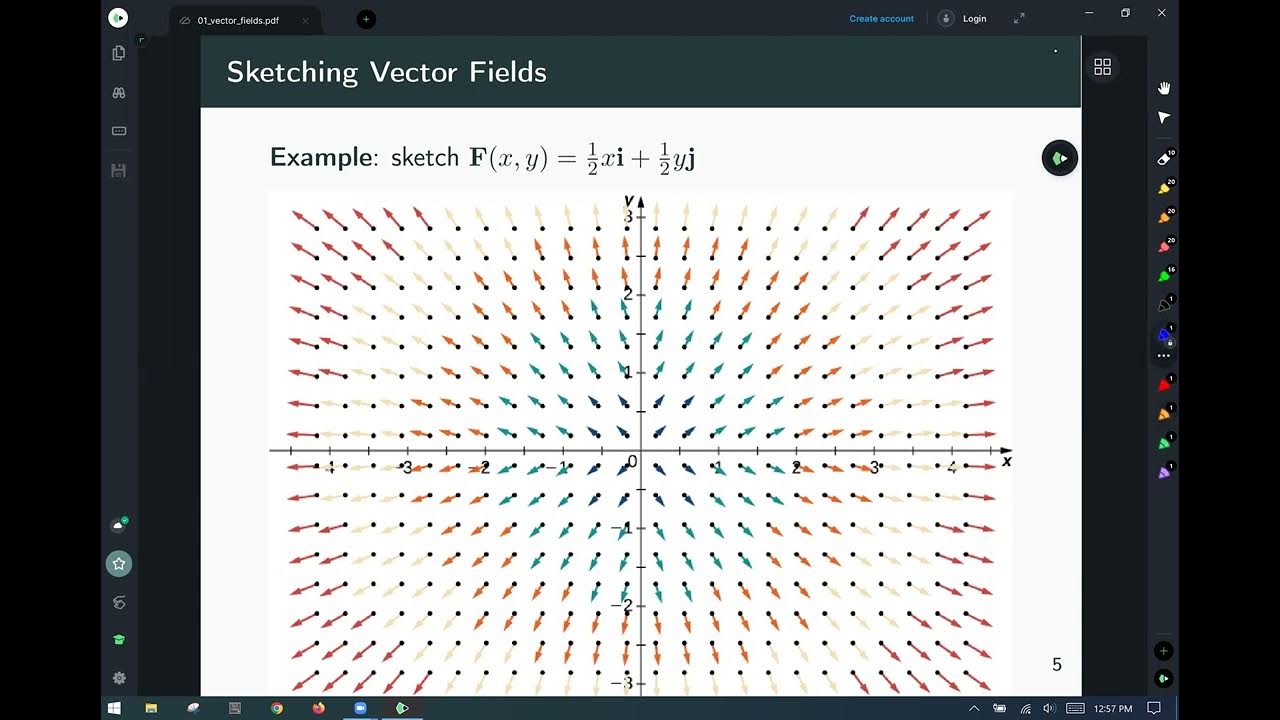Operazioni tra vettori in componenti cartesiane
Summary
TLDRThis video concludes an introductory lesson on vector calculus, focusing on vector operations using Cartesian components. It explains how to perform vector addition, subtraction, and scalar multiplication by simply adding or subtracting the respective components. The video introduces algebraic notation with versors, which simplifies vector operations by treating vectors as algebraic polynomials. The lesson highlights the efficiency of using Cartesian components for vector calculations, emphasizing that this approach is useful for solving complex problems without the need for graphical methods. The video encourages viewers to use algebraic rules for simpler vector operations.
Takeaways
- 😀 Vectors can be added and subtracted easily using their Cartesian components, eliminating the need for graphical methods like the parallelogram rule or tip-to-tail method.
- 😀 The sum of two vectors is calculated by adding their corresponding components (x and y coordinates) together.
- 😀 Vector subtraction works similarly to addition, where the components are subtracted: (Ax - Bx, Ay - By).
- 😀 Scalar multiplication of a vector involves multiplying each Cartesian component by the scalar (e.g., 3A results in multiplying the components of A by 3).
- 😀 Cartesian components provide a straightforward way to handle vector operations algebraically, making them essential in solving physical problems.
- 😀 Unit vectors (or versors) represent the basic directions along the x and y axes with a magnitude of 1, making them a useful tool in vector notation.
- 😀 The notation with unit vectors (e.g., 6x + 2y) simplifies vector representation, where x and y refer to the unit vectors along the axes.
- 😀 The sum of vectors can be treated like polynomial addition by combining like terms (adding x-components and y-components separately).
- 😀 The use of Cartesian components allows for easy computation of the magnitude of a vector using the Pythagorean theorem.
- 😀 Understanding vector operations through Cartesian components avoids reliance on graphical methods, making it easier to perform calculations in more complex physical scenarios.
- 😀 The vector notation involving versors (like 6x + 2y) simplifies algebraic operations, and this approach can be extended to vector differences and scalar multiplications.
Q & A
What is the purpose of learning vector components in this video?
-The purpose is to understand how to perform basic vector operations, such as addition, subtraction, and scalar multiplication, and apply them to solve physical problems more effectively.
How are vector components related to vector addition?
-Vector components simplify vector addition by allowing you to directly add the corresponding components along the x and y axes instead of relying on graphical methods like the parallelogram rule.
What are the components of vector A in the script?
-The components of vector A are Ax = 6 and Ay = 2, meaning it moves 6 units along the x-axis and 2 units along the y-axis.
What is the result of adding vectors A and B?
-The sum of vectors A and B is vector C, which has components Cx = 8 and Cy = 7. This is found by adding the corresponding components of vectors A and B (Ax + Bx for the x-component, Ay + By for the y-component).
How is vector subtraction performed using components?
-To subtract vector B from vector A, you subtract the components of B from the components of A: Dx = Ax - Bx and Dy = Ay - By. For example, if Ax = 6 and Bx = 2, then Dx = 4, and similarly for the y-components.
What is the formula for the sum of two vectors in component form?
-The sum of two vectors A and B in component form is given by Cx = Ax + Bx and Cy = Ay + By, where the components along each axis are added separately.
What does multiplying a vector by a scalar involve?
-Multiplying a vector by a scalar involves multiplying each component of the vector by the scalar. For example, if vector A has components Ax = 6 and Ay = 2, then 3A would have components 3*6 = 18 along the x-axis and 3*2 = 6 along the y-axis.
What are 'versors' and why are they useful?
-Versors are unit vectors along the x and y axes, denoted as x̂ and ŷ. They represent basic steps of length 1 along the respective axes and are used to express vectors in a simplified algebraic form.
How is vector A written using versors?
-Vector A can be written as 6x̂ + 2ŷ, where 6 represents the steps along the x-axis and 2 represents the steps along the y-axis, with x̂ and ŷ being the unit vectors along those axes.
How does the notation with versors simplify vector addition?
-Using versors to express vectors as sums of multiples of x̂ and ŷ simplifies vector addition by allowing you to apply algebraic rules for adding like terms (e.g., adding the x components and y components separately), which is similar to adding polynomials.
Outlines

Dieser Bereich ist nur für Premium-Benutzer verfügbar. Bitte führen Sie ein Upgrade durch, um auf diesen Abschnitt zuzugreifen.
Upgrade durchführenMindmap

Dieser Bereich ist nur für Premium-Benutzer verfügbar. Bitte führen Sie ein Upgrade durch, um auf diesen Abschnitt zuzugreifen.
Upgrade durchführenKeywords

Dieser Bereich ist nur für Premium-Benutzer verfügbar. Bitte führen Sie ein Upgrade durch, um auf diesen Abschnitt zuzugreifen.
Upgrade durchführenHighlights

Dieser Bereich ist nur für Premium-Benutzer verfügbar. Bitte führen Sie ein Upgrade durch, um auf diesen Abschnitt zuzugreifen.
Upgrade durchführenTranscripts

Dieser Bereich ist nur für Premium-Benutzer verfügbar. Bitte führen Sie ein Upgrade durch, um auf diesen Abschnitt zuzugreifen.
Upgrade durchführen5.0 / 5 (0 votes)






